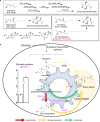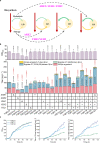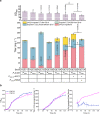Manipulation of sterol homeostasis for the production of 24-epi-ergosterol in industrial yeast
- PMID: 36707526
- PMCID: PMC9883489
- DOI: 10.1038/s41467-023-36007-z
Manipulation of sterol homeostasis for the production of 24-epi-ergosterol in industrial yeast
Abstract
Brassinolide (BL) is the most biologically active compound among natural brassinosteroids. However, the agricultural applications are limited by the extremely low natural abundance and the scarcity of synthetic precursors. Here, we employ synthetic biology to construct a yeast cell factory for scalable production of 24-epi-ergosterol, an un-natural sterol, proposed as a precursor for BL semi-synthesis. First, we construct an artificial pathway by introducing a Δ24(28) sterol reductase from plants (DWF1), followed by enzyme directed evolution, to enable de novo biosynthesis of 24-epi-ergosterol in yeast. Subsequently, we manipulate the sterol homeostasis (overexpression of ARE2, YEH1, and YEH2 with intact ARE1), maintaining a balance between sterol acylation and sterol ester hydrolysis, for the production of 24-epi-ergosterol, whose titer reaches to 2.76 g L-1 using fed-batch fermentation. The sterol homeostasis engineering strategy can be applicable for bulk production of other economically important phytosterols.
© 2023. The Author(s).
Conflict of interest statement
The authors declare no competing interests.
Figures




Similar articles
-
Novel cell factory for the production of 24-epi-ergosterol, an un-natural semi-synthetic precursor for the production of brassinolide in Yarrowia lipolytica.World J Microbiol Biotechnol. 2025 Mar 10;41(3):98. doi: 10.1007/s11274-025-04314-w. World J Microbiol Biotechnol. 2025. PMID: 40059252
-
Transcriptional regulation of the two sterol esterification genes in the yeast Saccharomyces cerevisiae.J Bacteriol. 2001 Sep;183(17):4950-7. doi: 10.1128/JB.183.17.4950-4957.2001. J Bacteriol. 2001. PMID: 11489845 Free PMC article.
-
Mobilization of steryl esters from lipid particles of the yeast Saccharomyces cerevisiae.Biochim Biophys Acta. 2009 Feb;1791(2):118-24. doi: 10.1016/j.bbalip.2008.11.004. Epub 2008 Dec 8. Biochim Biophys Acta. 2009. PMID: 19111628
-
Regulation of Ergosterol Biosynthesis in Saccharomyces cerevisiae.Genes (Basel). 2020 Jul 15;11(7):795. doi: 10.3390/genes11070795. Genes (Basel). 2020. PMID: 32679672 Free PMC article. Review.
-
[Reinforcement of sterols production through directed storage and transportation in yeast: a review].Sheng Wu Gong Cheng Xue Bao. 2021 Nov 25;37(11):3975-3987. doi: 10.13345/j.cjb.200772. Sheng Wu Gong Cheng Xue Bao. 2021. PMID: 34859638 Review. Chinese.
Cited by
-
Novel cell factory for the production of 24-epi-ergosterol, an un-natural semi-synthetic precursor for the production of brassinolide in Yarrowia lipolytica.World J Microbiol Biotechnol. 2025 Mar 10;41(3):98. doi: 10.1007/s11274-025-04314-w. World J Microbiol Biotechnol. 2025. PMID: 40059252
-
Engineered yeast provides rare but essential pollen sterols for honeybees.Nature. 2025 Aug 20. doi: 10.1038/s41586-025-09431-y. Online ahead of print. Nature. 2025. PMID: 40836088
-
De novo engineering of programmable and multi-functional biomolecular condensates for controlled biosynthesis.Nat Commun. 2024 Sep 12;15(1):7989. doi: 10.1038/s41467-024-52411-5. Nat Commun. 2024. PMID: 39284811 Free PMC article.
-
Phylogenomics and metabolic engineering reveal a conserved gene cluster in Solanaceae plants for withanolide biosynthesis.Nat Commun. 2025 Jul 10;16(1):6367. doi: 10.1038/s41467-025-61686-1. Nat Commun. 2025. PMID: 40640164 Free PMC article.
-
Identifying new targets for improving terpenoid biosynthesis in Yarrowia lipolytica through random genomic cytosine base editing.Microb Cell Fact. 2025 Aug 20;24(1):192. doi: 10.1186/s12934-025-02819-5. Microb Cell Fact. 2025. PMID: 40830463 Free PMC article.
References
-
- Gudesblat GE, Russinova E. Plants grow on brassinosteroids. Curr. Opin. Plant Biol. 2011;14:530–537. - PubMed
-
- Liu JN, et al. Structure-activity relationship of brassinosteroids and their agricultural practical usages. Steroids. 2017;124:1–17. - PubMed
-
- Grove MD, et al. Brassinolide, a plant growth-promoting steroid isolated from Brassica Napus pollen. Nature. 1979;281:216–217.
-
- Oklestkova J, Rarova L, Kvasnica M, Strnad M. Brassinosteroids: synthesis and biological activities. Phytochem. Rev. 2015;14:1053–1072.
Publication types
MeSH terms
Substances
LinkOut - more resources
Full Text Sources
Molecular Biology Databases

